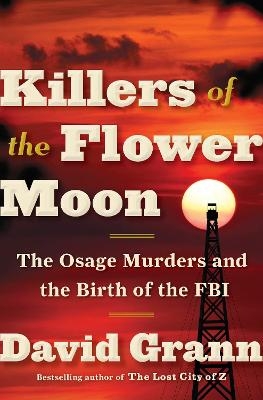
Killers of the Flower Moon
Doubleday & Co Inc. (Verlag)
978-0-385-54248-7 (ISBN)
- Titel ist leider vergriffen;
keine Neuauflage - Artikel merken
NEW YORK TIMES BESTSELLER - NATIONAL BOOK AWARD FINALIST
"Disturbing and riveting...It will sear your soul." -Dave Eggers, New York Times Book Review
SHELF AWARENESS'S BEST BOOK OF 2017
Named a best book of the year by Wall Street Journal, The Boston Globe, San Francisco Chronicle, GQ, Time, Newsday, Entertainment Weekly, Time Magazine, NPR's Maureen Corrigan, NPR's "On Point," Vogue, Smithsonian, Cosmopolitan, Seattle Times, Bloomberg, Lit Hub's "Ultimate Best Books," Library Journal, Paste, Kirkus, Slate.com and Book Browse
From New Yorker staff writer David Grann, #1 New York Times best-selling author of The Lost City of Z, a twisting, haunting true-life murder mystery about one of the most monstrous crimes in American history
In the 1920s, the richest people per capita in the world were members of the Osage Indian nation in Oklahoma. After oil was discovered beneath their land, they rode in chauffeured automobiles, built mansions, and sent their children to study in Europe.
Then, one by one, the Osage began to be killed off. The family of an Osage woman, Mollie Burkhart, became a prime target. Her relatives were shot and poisoned. And it was just the beginning, as more and more members of the tribe began to die under mysterious circumstances.
In this last remnant of the Wild West-where oilmen like J. P. Getty made their fortunes and where desperadoes like Al Spencer, the "Phantom Terror," roamed-many of those who dared to investigate the killings were themselves murdered. As the death toll climbed to more than twenty-four, the FBI took up the case. It was one of the organization's first major homicide investigations and the bureau badly bungled the case. In desperation, the young director, J. Edgar Hoover, turned to a former Texas Ranger named Tom White to unravel the mystery. White put together an undercover team, including one of the only American Indian agents in the bureau. The agents infiltrated the region, struggling to adopt the latest techniques of detection. Together with the Osage they began to expose one of the most chilling conspiracies in American history.
In Killers of the Flower Moon, David Grann revisits a shocking series of crimes in which dozens of people were murdered in cold blood. Based on years of research and startling new evidence, the book is a masterpiece of narrative nonfiction, as each step in the investigation reveals a series of sinister secrets and reversals. But more than that, it is a searing indictment of the callousness and prejudice toward American Indians that allowed the murderers to operate with impunity for so long. Killers of the Flower Moon is utterly compelling, but also emotionally devastating.
DAVID GRANN is a staff writer at The New Yorker and the bestselling author of The Devil and Sherlock Holmes and The Lost City of Z , which has been translated into more than twenty languages. His stories have appeared in many anthologies of the best American writing, and he has written for The New York Times Magazine , The Atlantic , The Washington Post , The Wall Street Journal , and The New Republic .
David Grann is a staff writer at The New Yorker and the best-selling author of The Lost City of Z, which was chosen as one of the best books of the year by The New York Times, The Washington Post, and other publications and has been translated into more than twenty-five languages. He is also the author of The Devil and Sherlock Holmes. His work has garnered several honors for outstanding journalism, including a George Polk Award.
Chapter 1 The Vanishing In April, millions of tiny flowers spread over the blackjack hills and vast prairies in the Osage territory of Oklahoma. There are Johnny-jump-ups and spring beauties and little bluets. The Osage writer John Joseph Mathews observed that the galaxy of petals makes it look as if the "gods had left confetti." In May, when coyotes howl beneath an unnervingly large moon, taller plants, such as spiderworts and black-eyed Susans, begin to creep over the tinier blooms, stealing their light and water. The necks of the smaller flowers break and their petals flutter away, and before long they are buried underground. This is why the Osage Indians refer to May as the time of the flower-killing moon. On May 24, 1921, Mollie Burkhart, a resident of the Osage settlement town of Gray Horse, Oklahoma, began to fear that something had happened to one of her three sisters, Anna Brown. Thirty-four, and less than a year older than Mollie, Anna had disappeared three days earlier. She had often gone on "sprees," as her family disparagingly called them: dancing and drinking with friends until dawn. But this time one night had passed, and then another, and Anna had not shown up on Mollie's front stoop as she usually did, with her long black hair slightly frayed and her dark eyes shining like glass. When Anna came inside, she liked to slip off her shoes, and Mollie missed the comforting sound of her moving, unhurried, through the house. Instead, there was a silence as still as the plains. Mollie had already lost her sister Minnie nearly three years earlier. Her death had come with shocking speed, and though doctors had attributed it to a "peculiar wasting illness," Mollie harbored doubts: Minnie had been only twenty-seven and had always been in perfect health. Like their parents, Mollie and her sisters had their names inscribed on the Osage Roll, which meant that they were among the registered members of the tribe. It also meant that they possessed a fortune. In the early 1870s, the Osage had been driven from their lands in Kansas onto a rocky, presumably worthless reservation in northeastern Oklahoma, only to discover, decades later, that this land was sitting above some of the largest oil deposits in the United States. To obtain that oil, prospectors had to pay the Osage for leases and royalties. In the early twentieth century, each person on the tribal roll began receiving a quarterly check. The amount was initially for only a few dollars, but over time, as more oil was tapped, the dividends grew into the hundreds, then the thousands. And virtually every year the payments increased, like the prairie creeks that joined to form the wide, muddy Cimarron, until the tribe members had collectively accumulated millions and millions of dollars. (In 1923 alone, the tribe took in more than $30 million, the equivalent today of more than $400 million.) The Osage were considered the wealthiest people per capita in the world. "Lo and behold!" the New York weekly Outlook exclaimed. "The Indian, instead of starving to death . . . enjoys a steady income that turns bankers green with envy." The public had become transfixed by the tribe's prosperity, which belied the images of American Indians that could be traced back to the brutal first contact with whites-the original sin from which the country was born. Reporters tantalized their readers with stories about the "plutocratic Osage" and the "red millionaires," with their brick-and-terra-cotta mansions and chandeliers, with their diamond rings and fur coats and chauffeured cars. One writer marveled at Osage girls who attended the best boarding schools and wore sumptuous French clothing, as if "une très jolie demoiselle of the Paris boulevards had inadvertently strayed into this little reservation town." At the same time, reporters seized upon any signs of the traditional Osage way of life, which seemed to stir in th
| Erscheinungsdatum | 05.04.2017 |
|---|---|
| Zusatzinfo | 73 PHOTOS IN TXT; ENDPR MAPS |
| Verlagsort | New York |
| Sprache | englisch |
| Maße | 155 x 234 mm |
| Gewicht | 485 g |
| Themenwelt | Literatur ► Biografien / Erfahrungsberichte |
| Literatur ► Krimi / Thriller / Horror | |
| Geschichte ► Allgemeine Geschichte ► 1918 bis 1945 | |
| Geschichte ► Teilgebiete der Geschichte ► Kulturgeschichte | |
| Sozialwissenschaften ► Ethnologie | |
| Sozialwissenschaften ► Soziologie | |
| Schlagworte | Al Spencer • American West • conspiracy • Cowboy • Englisch; Krimis/Thriller • FBI (Federal Bureau of Investigation); Krimis/Thriller • Indian reservation • Indians • J. Edgar Hoover • J.P. Getty • Lost City of Z • Mass murder • Native American History • Oil business • Oklahoma • Osage Indian Nation • Osage Indians • Osagen • private detectives • Texas Rangers • True Crime • True Crime / Kriminalfälle • USA, Geschichte • Wild West |
| ISBN-10 | 0-385-54248-8 / 0385542488 |
| ISBN-13 | 978-0-385-54248-7 / 9780385542487 |
| Zustand | Neuware |
| Haben Sie eine Frage zum Produkt? |
aus dem Bereich


